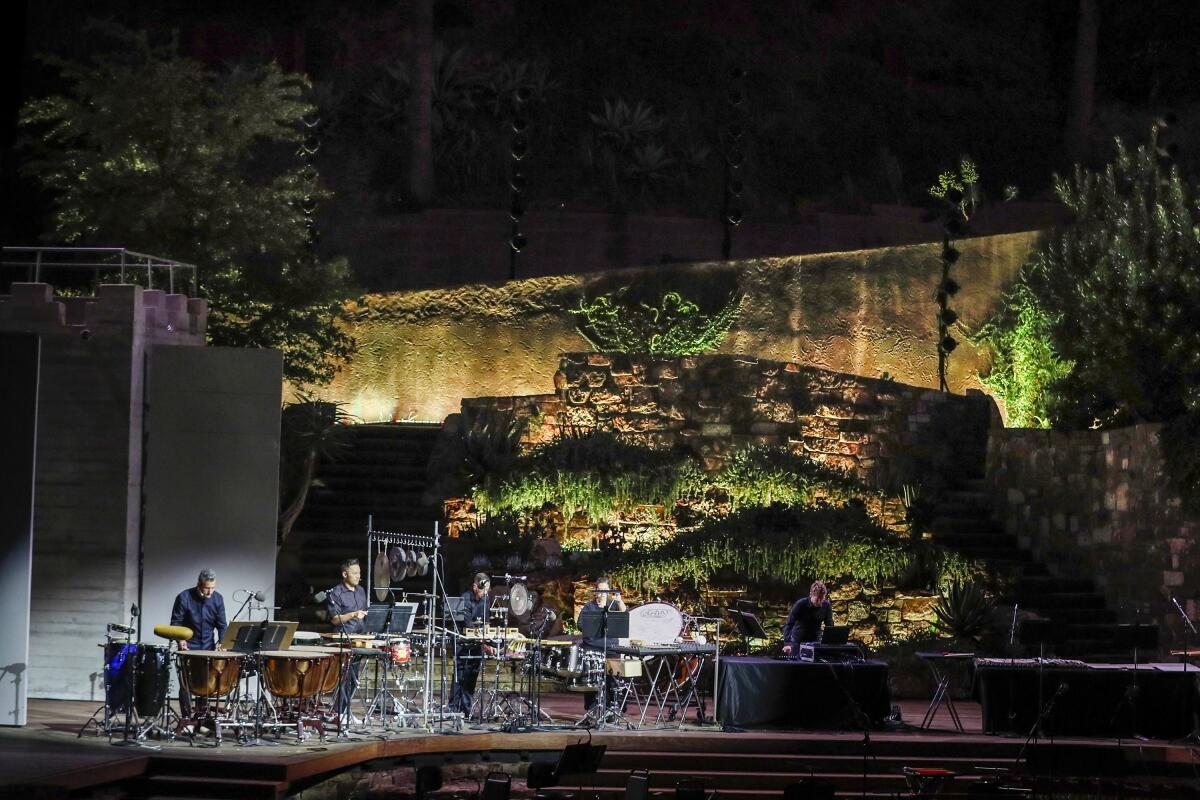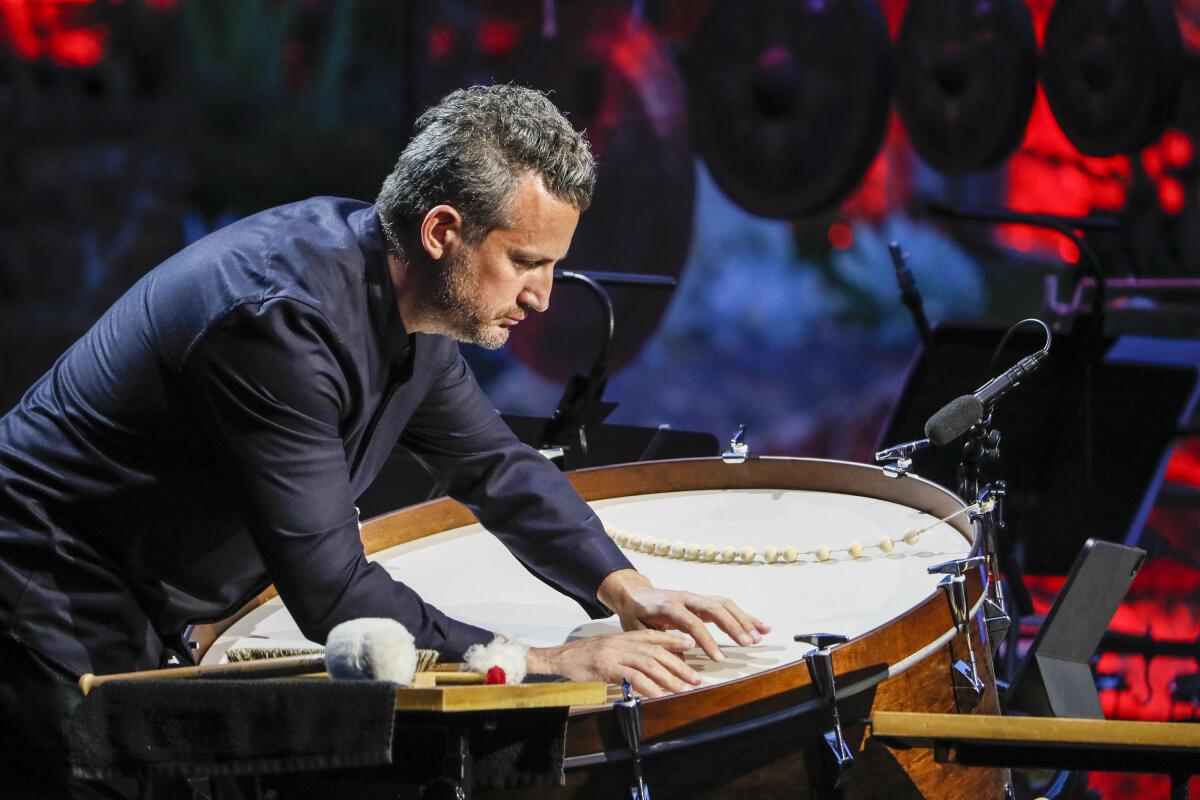Review: On a moonlit night, new music and nature meet at the Ford under a Green Umbrella

- Share via
There were no green umbrellas Wednesday night when the Los Angeles Philharmonic presented a Green Umbrella concert for the first time at the Ford. Even if the green umbrella happens to be the surreal symbol of the L.A. Phil New Music Group’s prophetic concert series, now celebrating its 35th anniversary, a quaint artifact meant to shield us from something once known as rain would have looked ridiculous at the Ford, with its beauteous green and rugged hillside backdrop behind the stage.
Chosen a century ago as a natural setting for spiritual pageantry, the site of the Ford remains an excellent site to ponder art and environment. That isn’t necessarily the venue’s purpose. Run by the L.A. Phil since 2020 at L.A. County’s request, the Ford mainly serves to present a wide range of musical genres at more or less popular prices. The L.A. Phil seems to be otherwise keeping classical music out of its way, having three other enviable venues — Walt Disney Concert Hall, the Hollywood Bowl and the Beckmen YOLA Center — for that.
For the record:
2:19 p.m. July 10, 2022An earlier version of this article stated that the Green Umbrella series was celebrating its 40th anniversary. It is marking its 35th year.
But new music fits the Ford just fine. Wednesday may have been a new-music program without the usual Green Umbrella bells and whistles, so to speak. No composers arrived to talk about their music. No program notes. If you wanted to know what was being played, you had to pull out your phone and find that on an app. If you wanted to know something about the music, you could try Google and hope for the best.
No helpful bells and whistles, but the stage boasted plenty of percussion noise makers onstage. Ticket prices were kept at a reasonable $20 for all seats, attracting a mostly young crowd and some families with young children. The pieces were short, between four and 15 minutes, and varied. Percussion pieces, curated and led by L.A. Phil principal timpanist Joseph Pereira, dominated. Music was heard simply as music, take it or leave it.
Maybe it was just as well that there were no program notes for the short opening piece, Gérard Grisey’s “Stèle,” in which two percussionists, on opposite sides of the stage, hit big bass drums, slowly building an impressive sonic and rhythmic profile. Grisey’s intent was to evoke the mysterious unearthing of an ancient ceremonial stone slab (or stela).
Around the same time “Stèle” was written, the L.A. Phil commissioned one of Grisey’s last pieces, “L’Icône Paradoxale.” A Times review mercilessly ridiculed the French composer’s explanations of his “spectral” technique, a fanciful use of the harmonic overtone series to create a sense of aural wonderment in the listener. “Stèle” did just that at the Ford. Not only have times significantly changed but, in the great Ford outdoors, a stela from a Theosophical Society pilgrimage placed a century ago could easily be imagined buried on the hillside.

What followed was one different kind of music after another, each entering into an interplay with the not always benign environment. Vivian Fung’s “Pizzicato,” a string orchestra arrangement of a movement from her First String Quartet, begins with plucked strings and ends with the players tapping the wood of their instruments as though they were percussion. At the Ford, a small plane suddenly flew overhead and entered into sonic play with that tapping.
Had this been a string quartet concert, the effect would have produced an ugly intrusion. But since percussion and electronics were meant to be a significant part of the evening, and everything was prominently amplified, I heard the plane as an improvement.
The most striking piece was Juan Felipe Waller’s “Teguala” for amplified tiles and electronic playback. In a dazzling display of rub, rattle and roll, four percussionists hit dozens of Mexican tiles with mallets, while a fifth fiddled with a laptop. The Mexican Dutch composer, who appears to have one foot in the kinds of spectral electronics that Grisey pioneered and the other in Mexican musical traditions, builds musical structures from complex interlocking rhythms, while the electronics sound like trucks or trains rumbling through, mosquitos buzzing next to your ear, crickets chirping in the woods, planes whirring overhead. I can’t say for sure whether some of those sounds were from the environment instead of the performance.
Gabriella Smith’s “Riprap” for marimba and strings, which followed the intermission, was written in 2013, the year the composer from Berkeley got her bachelor’s degree in composition from the Curtis Institute of Music in Philadelphia and turned 22. The Los Angeles Chamber Orchestra gave it its L.A. premiere three years ago, by which time Smith had already become an L.A. sensation and has since been eagerly commissioned by the L.A. Phil and featured at the Ojai Festival.
“Riprap” has the freshness, zest and originality of a young Mendelssohn. The strings make delightful sounds. The marimba dances around them. Underlying all of Smith’s music, however, is a deep involvement in environmental issues, presenting music as a representative of what the world around us might be and might not continue to be. The sun had set for “Riprap,” and stage lighting made the hillside appear dark and mysterious. But the outside remained friendly, with no disturbances for this happy music, happily performed.
The final piece was Kaija Saariaho’s “Trois Rivières” (Three Rivers). Four percussionists rhythmically speak a French translation of 8th century Chinese poet Li Po’s “La nuit de lune sur le fleuve” (Moonlit night on the river) while playing an extensive collection of instruments. A fifth percussionist operates surround-sound electronics.
The night was moonlit. I had moved by this point to an empty section of seats furthest back from the stage, as mask-wearing is not yet back in fashion at the Ford. The theater isn’t large, but I was too far back to make out the instruments, and the electronics added to the feeling of being in a cavernous space.
Words barely comprehended, a panoply of percussive sounds and the reverberant electronic ambience all contributed to producing an uncanny sensation of being in the remove of nature. How that could be, I cannot say. But when a plane flew overhead, it felt too distant to matter.
More to Read
The biggest entertainment stories
Get our big stories about Hollywood, film, television, music, arts, culture and more right in your inbox as soon as they publish.
You may occasionally receive promotional content from the Los Angeles Times.











